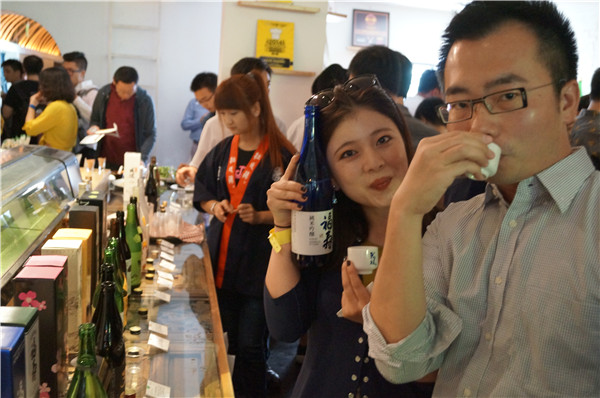 |
|
A sake tasting event in Beijing. [Photos Provided To China Daily] |
If you have come across sake, Japanese rice wine, at all, chances are that you were in a sushi bar when you did so. This warm, fiery drink is served in teacup doses and is a little more bitter than some white wines but is not as aggressive as the Chinese spirit baijiu.
But then again, there is sake and there is sake, and given that it is such an exotic drink, unless you are Japanese or an aficionado, you are unlikely to know the difference between the exquisitely good and the excruciatingly bad.
One thing that makes sake rare among alcoholic beverages is that it can be heated and served at the temperature of, say, coffee or soup. However, Taka Yamamoto, 41, a sake expert, says good sake is best served cold.
With the growing popularity of sushi, sashimi and other Japanese cuisine in China - there are reckoned to be 1,000 dining establishments in Beijing and 2,000 in Shanghai that feature Japanese food - the band of those who can appreciate good sake is beginning to grow.
Sake experts in Beijing are few and far between, but Yamamoto, from the small city of Matsusaka in southern-central Japan that is famous for its beef, is an International Wine Challenge sake judge and sake master, and has promoted sake culture in China for the past 15 years.
The earthquake and tsunami that struck the east coast of Japan in March 2011 severely disrupted his export company's operations and it took him more than a year to get it back on its feet, but since then, he says, its sake exports to China have grown about 25 percent each year.
Still, it is one thing to drink sake and another to be knowledgeable about what you are pouring down your throat. First, Yamamoto says, there are many misconceptions about the drink.
"There are myriad wine shows, but no sake shows in Beijing where people can do tasting, talk to brewers and learn about sake culture. Knowledge comes with trying and tasting. In that regard, Shanghai is a bit better than Beijing, but a lot more needs to be done."
Last month a sake carnival that Yamamoto organized in Beijing featured more than 100 kinds of fine sake brought in from Japan, and a group of senior brewers was flown in as well.
The four-hour show, held at the same time as lectures about sake, drew about 300 attendees. Some of the popular brands at the show were Kitaya Gokujo, Kamenokou 22, Born Wing of Japan, and Horaisen Bi.
Yamamoto says that 15 years ago, two years after having completed Chinese-language studies in Beijing he returned to the capital as a salesman for a Japanese sake brewery.
He now owns the boutique sake collection Tojikura, that name being a compound of two words, toji, meaning head sake brewer, and kura, meaning storehouse. He also owns two Japanese restaurants and bars in Beijing: Sake Manzo and Happi Sake.
In China a premium bottle of sake tends to be more expensive than comparable beer and wine at an entry level. A bottle of sake that costs anything less than 200 yuan ($31.50) is likely to be substandard, Yamamoto says. Prices for his imported sake range from 400 yuan to 6,000 yuan a bottle.
The high prices in China reflect taxes on imported sake that can amount to as much as 85 percent of the original price in Japan, in addition to the costs of cold-chain transport and distribution, he says.
|
|
|
|
|
|
|
|
